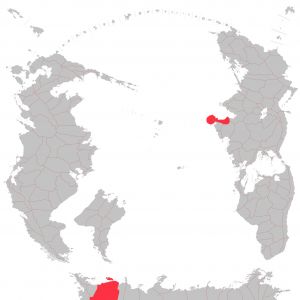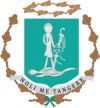Izaakia (Pacifica)
The United States of Izaakia Imperium Montacia et la Rein Izaakia | |
|---|---|
 Location of Izaakia in Pacifica | |
| Location | West Keyli and West Bailtem |
| Capital | Izaakston |
| Largest city | New Mako City |
| Official languages | Austral, Montacian, Boreal, Brodlancian |
| Demonym(s) | Izaakian |
| Government | Democratic Constitutional Empire |
| Astrid Iceborn | |
| Dr Stella Blanc | |
| Charles Bounlangerie | |
| Athena Popadomalus | |
| Legislature | Parliament |
| House of Commons | |
| House of Lords | |
| Formation | |
• Kingdom of Montacia | 1400BCE |
• Kingdom of Izaakia | 1607CE |
• Izaakian Empire | 2020CE |
| Area | |
• Total | 324,935 km2 (125,458 sq mi) |
| Population | |
• 2020 census | 96,000,000 |
• Density | 6/km2 (15.5/sq mi) |
| GDP (nominal) | 2020 estimate |
• Total | $5.65 Trillion (1) |
• Per capita | $59,000 (5) |
| Gini | 35.0 medium |
| HDI | 0.96 very high |
| Currency | Izaakian Shark Tooth (IST) |
| Time zone | UTC0 (IST) |
| Date format | dd/mm/yyyy |
| Driving side | left |
| Calling code | +07 |
| World Forum Code | IZ |
| Internet TLD | .iz |
The United States of Izaakia is the largest nation in the Keyli continent, and has 2 overseas territories, with a total Area of 324,935km^2 north of the 70th parallel (Izaakia claims all land south of the 70th parallel (15,500,000km2) these claims are disputed). The population of Izaakia is 96 million Million, mostly concentrated on the northern coast of Keyli and the coasts of La Montagne and Brödmark, with large population centres in the capital Izaakston (5 Million), Port Vent (9 Million), Hopstown (7 Million) and New Mako (14 million).
The Izaakian political system is officially a Constitutional Monarchy, with Empress Astrid Iceborn remaining head of state, however she now has no constitutional powers or rights outside the right to consult and be Informed. There is a democratically elected federal government led by Prime Minister Valkyrie Mountbatten with devolved governments in each of the 3 nations and the New Mako-Izaakston conurbation . Economically the nation of Izaakia is highly developed with a relatively high manufacturing output, led by the furniture producer Izea, the technology firm Taiga and all terrain car manufacturer Ice Shark. Outside of the manufacturing sector, Izaakia takes advantage of its location along shipping lanes between the Cordilian Sea and the Brevelo Sea, with New Mako being a global shipping centre, there is also a large environmental tourism sector. The nations of Brödmark and La Montagne are not developed as highly as Izaakia, however they do have successful economies in agriculture, tourism, mining(particular la montane), finance, manufacturing and arms production.
Etymology
Izaakia is named after the old Montacian word for freedom, Izkän. This name was adopted after the Imperial Family, Elites and Loyal Polytheists escaped from the rising tide of Christianity in La Montagne and Brödmark in 16th Century.
History
Prehistory
Very little is known about the prehistoric origins of the Izaakian people, they first emerged from the la Montagne region. Prehistoric bones and weapons suggest a highly violent culture, however the relative good health is shown in the bones by large structure. There are stone circles that align with the sun and the moon, however the true nature of these has been lost to history. The most famous stone circle, the Montacian Foundation circle, it is 8000 years old and sits atop the la Montagne mountain and is the center peace of the old imperial capital La Citadelle.
Antiquity
The first recorded history of the Montacian people that would later become the izaakians is not from the Montacians, but nearby coastal peoples. In around 1400 BCE a mysterious Sea People began to raid, pillage and rape along the Near Western coast of Bailtem. The ancient city states and nations had never encountered these people, or the language before, due to the geographic isolation of la Montagne. In around 1350 these raids suddenly stop.
By this point Montacian history starts, the Montacian people had learnt to read and write from their captives, and the first Montacian chronicles and myths start. From these early documents we know that La Montagne was split between many powerful and warring city states, and that after a relatively peaceful period at home where the montacians struck out a period of great internal strife occurred. Over the next 150 years until approximately the year 1200BCE by modern reckoning, the city states fought for supremacy and eventually the Iceborn family from the icey peaks of la Citadelle became emperors of all they surveyed from their lofty capital.
The fact that these emperors came from the harsh icey tops of mountains is significant in Montacian history as the difficult conditions where all hands were required led to a gender parity that is a consistent feature in Montacian/Izaakian history, but early sources show this was not the case on the warmer shores of la Montagne.
The first emperor of the montacians was Plutarch the Wise, and in many ways he has dominated the national philosophy of the following 3 millennia. Of all the ancient Montacian gods, the Goddess that Plutarch the Wise worshiped the most ferociously was Inteligencia the goddess of Wisdom, Knowledge and Engineering. Plutarch the Wise set about building his dynasty, securing his grip around the peninsula. He build great roads, aqueducts, schools and temples, some of the great Montacian wonders exist from this time, including the Great Montacian Library, and the the Temple to Oceanus. He also encouraged a culture of learning, philosophy and free thinking. He died in 1164 BCE after a long rein and was succeeded by Augustus the Builder.
Augustus the builder fought many boundary battles on the edge of the peninsula, and finally after a decade of battles ending in stalemate he became weary and built the great Montacian wall build by slaves over 7 years, cutting off La Montagne from the continent by land. Secure behind his great walls Augustus the builder started a project that lasts even to this day, he terraced the great mountain, creating agricultural land across most of the nation, providing a wide variety of food and secure from the great famines. He also build the ancient dam, dedicated to the goddess Montacia, the Queen of the gods and goddess of the mountain. Augustus the builder died in 1132 BCE and was succeeded by Anthony the Explorer.
Anthony the explorer was born at the right time in history, his 2 great predecessors had built a secure and safe nation. As a prince he had built the dockyards at Port Ventacia, and built a great many trending ships. Upon the start of his rule, he left his younger sister Atlantia to govern, and set out to discover and explore new lands. He made contact with many nations and city states up and down the coast of Bailtem, bringing back great bounties of plants and knowledge. He also set the precedent of coastal trading along the coast by Izaakian ships. However, after a short reign of just 6 years, he was Killed by King Nebuchadnezzar of the city state Spirio. He was tortured and impaled, then still alive thrown in to the burning bull, a hollow bronze bull with an inferno burning bellow. The screams and smells were said to have shocked the Izaakian Sailors who were spared to send the warning back to stay away.
In 1126BCE Atlantia succeeded her brother as the first Montacian Empress since unification. She was later to be known as Atlantia the Patient Fury. The first year of her reign was spend in mourning, and she built a great temple to her ancestors later known as the dead city of emperors, she the reburied her parents and grand parents there, leaving an empty open grave for her brother. She then spent the next 5 years training the most formidable army, and navy the world had ever seen, before finally setting sail for Spirio in 1120BCE. She captured the beach and surrounding farmland and towns with great ease, and lay siege to the great fortress city of Spirio. Unusually for an invasion, Atlantia had brought the great thinkers of Montacia with her, and they proceeded to build the first siege weapons of the Izaakian Ancients. They built contraptions to hurl rocks at the walls and corpses aver the walls, they made vases of burning oil, that would smash when thrown and set fire to the ground. However, these would not break the Spirionese spirit. After 2 years the supplies within the great city of spirio were running out, and the elders of the city murdered King Nebuchadnezzar and opened the gate hoping for mercy. Mercy was not granted, and all things living within the city were killed, every building dismantled and burned, the surrounding land was salted and evidence of their culture destroyed. A pillar was erected on the site of the burned city engraved with the words, Let this site be a monument to the Montacian Fury that will befall those who cross us.
Empress Atlantia gathered a box of ash from the city, and interred it in the grave of her brother. Feeling the heavy burden of her actions, she laid in her own annex of the dead city of emperors and lay there, not drinking and eating, until after 11 days she succumbed and died.
In 1117BCE she was succeeded by her daughter Empress Diana the Consolidator. Empress Diana was at the siege of Spirio and had proved to be a wise and capable commander. She was also intelligent and observant, seeing how effective these new siege weapons, the disciplined troops and the navy had become. She established 3 schools to warfare, the Antonian school of Land Warfare, the Atlantian School of Naval Warfare, and the Diana School of Siege Warfare. She also established the first Montacian university and perhaps the first university in the world, The Imperial University was founded in 1115BCE with the aim to learn and debate philosophy and science. The formidable fighting reputation led to a relatively stable time period free from invasion until 452 BCE. Over the next 650 years Montacia had stable but largely insignificant emperors, building wealth through trade and knowledge through her great universities and schools.

